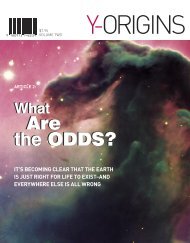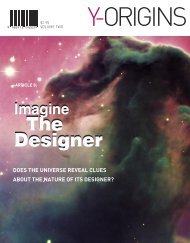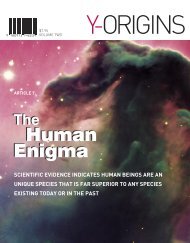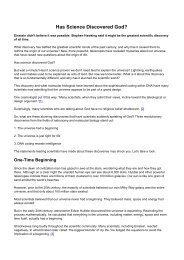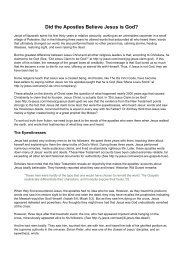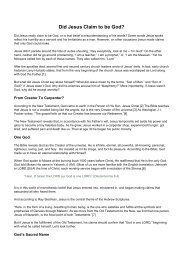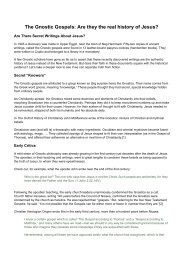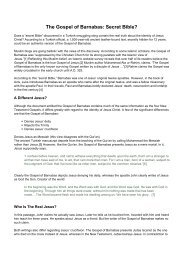missing_link6
Create successful ePaper yourself
Turn your PDF publications into a flip-book with our unique Google optimized e-Paper software.
$7.95<br />
VOLUME TWO<br />
Y-ORIGINS<br />
ARTICLE 6:<br />
The Case<br />
of the<br />
Missing Link<br />
SUDDEN APPEARANCE OF COMPLEX<br />
LIFE-FORMS POINTS TO<br />
INTELLIGENT DESIGN
INSTRUCTIONS<br />
To view the layout and graphics, click on the Facing icon on the<br />
right side of your bottom tool bar in your Acrobat Reader © file. Try viewing at 75%.<br />
To read the article, click on the Single Page icon on the bottom right of your<br />
Acrobat Reader © file.<br />
To enlarge the print for easier viewing, click on the “+” by the<br />
magnifcation percentage in the middle of the tool bar at the top of the page.<br />
To move from one page to another, use your side scroll bar or click on the<br />
left or right arrow in the bottom tool bar.<br />
CLICK HERE to see other articles from Y-Jesus Magazine at www.y-zine.com<br />
Chief Editor: Larry Chapman<br />
Project Coordinator: Helmut Teichert<br />
Editorial Director: Rick James<br />
Design: Hydragraphik ® Studio ( www.hydragraphik.com )<br />
Sun Mountain Productions<br />
Article Editors: Rick James, Eric Stanford<br />
Copy Editor: Eric Stanford<br />
Writers: Larry Chapman, Rick James, Eric Stanford<br />
Y-ZINE<br />
PO Box 6017<br />
Great Falls, MT 59405<br />
Copyright 2006 by Bright Media Foundation and B & L Publications. All rights reserved.<br />
ISBN 0-9717422-3-5<br />
2 • Y-JESUS
The Case of the Missing Link<br />
Click on the e-article title for contents<br />
SUDDEN APPEARING OF COMPLEX LIFE-FORMS<br />
POINTS TO INTELLGENT DESIGN Page 6<br />
DARWIN HAD TWO THEORIES Page 7<br />
THE ROCKS TALK Page 8<br />
BOOM—LIFE Page 8<br />
LIFE-FORMS IN A RUT Page 10<br />
GRADUATING FROM GRADUALISM Page 11<br />
EVOLUTION WITH A PURPOSE Page 11<br />
DARWIN’S OWN VERDICT Page 13<br />
ENDNOTES Page 13<br />
ACKNOWLEDGMENTS<br />
I am indebted to Dr. Bill Bright, who passed away before this project was finished. Dr. Bright enthusiastically endorsed and<br />
contributed to the development of the material presented in this endeavor.<br />
Special thanks are also due to Rick James and Eric Stanford, who have both spent countless hours clarifying some of the concepts<br />
presented.<br />
Several others have contributed greatly to the writing of these articles, including Dr. Henry Brandt, Dave Chapman, Dr. Bert<br />
Harned, and New Testament scholar, Dr. Ron Heine. The valuable input from Brian Ricci, ‘Jamin Latvala, and the Campus Crusade<br />
staff at the University of Washington were especially helpful and constructive. Special thanks also are due Helmut Teichert of<br />
Bright Media, who has been the overall director of the project. Finally I would like to thank my wife, Marianne, for inspiring me to<br />
undertake this effort.<br />
Larry Chapman<br />
TABLE OF CONTENTS • 3
THE CASE<br />
OF THE<br />
MISSING<br />
LINKS<br />
4 • THE CASE OF THE MISSING LINK • ARTICLE 6
Sudden appearing<br />
complex life-forms<br />
points to<br />
intelligent design.<br />
THE CASE OF THE MISSING LINK • ARTICLE 6 • 5
The discovery of DNA has revolutionized the<br />
world of forensic evidence. Cold case files<br />
have been reopened. Criminals who thought<br />
they had beaten the system have been<br />
belatedly prosecuted by a swab of saliva or<br />
body fluids forgotten about for decades. And<br />
in some instances, the new evidence has<br />
exonerated innocent prisoners.<br />
Herman Atkins was just 20 years old when<br />
his life began to fall apart. He was imprisoned<br />
in January, 1986 for wounding three<br />
people in a shooting spree in South-Central<br />
Los Angeles. Prior to his imprisonment a<br />
“Wanted” poster had been widely circulated.<br />
Later, at a sheriff’s substation, a 23 year-old<br />
rape victim glanced at a “Wanted” poster on<br />
a nearby table that showed a young black<br />
fugitive from Los Angeles. In court, she testified<br />
that she turned to her mother and said,<br />
“That’s him,” and pointed at the picture of<br />
Herman Atkins.<br />
A clerk from an adjoining business where<br />
the attacker stopped briefly before the rape<br />
also identified Atkins. Based primarily upon<br />
these eyewitness testimonies, the jury found<br />
Herman Atkins guilty of rape and robbery.<br />
His sentence: 47 years, 8 months in prison.<br />
Atkins spent thirteen years, three months,<br />
and six days in state prison, but not for a<br />
crime he had committed. His cold case had<br />
been reopened, and the DNA evidence had<br />
revealed that Atkins was not the rapist. On<br />
February 18, 2000 he walked out a free man,<br />
the victim of mistaken identity.<br />
Just as DNA has revolutionized criminal<br />
forensics, the work of paleontologists has<br />
shed new light on human origins. Being an<br />
honest man, Charles Darwin made no bones<br />
(pardon the pun) about predicting that the<br />
forensic fossil evidence would ultimately<br />
prove his theory right or wrong.<br />
But just as experts can jump to the wrong<br />
conclusion with regard to criminal evidence,<br />
so in the world of paleontology, a tooth, jaw,<br />
or piece of skull has often created premature<br />
headlines of “Missing Link Found.” Paleontologist<br />
Michael Boulter summarizes the<br />
problem with identifying fossils correctly:<br />
It’s very hard to piece together a few<br />
broken bones from a fossilized group<br />
of differentially aged primates scattered<br />
over a desert or cave floor and to<br />
be sure that they come from the same<br />
animal….It follows that the reliability<br />
of any description that attempts to<br />
recognize an actual species cannot be<br />
totally objective. 1<br />
Boulter is alluding to the fact that, being human,<br />
most scientists look at a fossil through<br />
the lens of their own presuppositions. For example,<br />
those who wanted to make a case for<br />
humans descending from apes were quick<br />
to jump with joy over the supposed discovery<br />
of the “<strong>missing</strong> link” called Piltdown Man.<br />
Featured in the London Times, New York<br />
Times, and various science journals, they<br />
made it a textbook example of the connection<br />
between apes and humans. However,<br />
forty years later, in 1953, it was revealed as<br />
a fraud.<br />
Frauds like the Piltdown Man are rare, and<br />
although objectivity is often lacking, there is<br />
actually a wealth of fossil evidence depicting<br />
the history of life on our planet.<br />
So in order to see what the forensic evidence<br />
says about Darwin’s theory, we need to<br />
hear from paleontologists themselves about<br />
6 • THE CASE OF THE MISSING LINK • ARTICLE 6
the evidence they have gathered during<br />
the nearly 150 years since he launched<br />
his theory. Our starting point is to clearly<br />
understand the predictions Darwin made<br />
regarding his theory and the fossils that<br />
should have resulted.<br />
DARWIN’S<br />
TWO THEORIES<br />
Charles Darwin was not the first to believe<br />
that life could arise by purely natural processes.<br />
In fact, the idea can be traced back<br />
as far as ancient Greece. And surely long<br />
before Darwin, people made the casual<br />
observation, “Hey, that guy kind of looks<br />
like a chimp.” But it was Darwin who gave<br />
the ideas intellectual teeth, or viability,<br />
through his observation and hypothesizing<br />
of several processes, including adaptation<br />
and natural selection.<br />
Few people realize that Darwin’s theory<br />
of evolution predicts two different results:<br />
microevolution and macroevolution. We will<br />
look at microevolution first.<br />
His micro-evolutionary theory states that<br />
variations within a species (cats, dogs,<br />
humans) can produce radical changes<br />
over time. He stated that sometimes these<br />
changes are accelerated by environmental<br />
conditions. For example, while on the Galapagos<br />
Islands, Darwin observed finches<br />
that had apparently grown slightly longer<br />
beaks during drought conditions. This<br />
confirmed his belief that creatures adapt to<br />
their environments.<br />
evolution. It is the scientific account of why<br />
the living world comes in so many shapes<br />
and sizes: how the giraffe got its long neck,<br />
why porpoises look so much like sharks …<br />
how birds fly.” 2<br />
Darwin believed that overpopulation of a<br />
species creates food shortages, which result<br />
in a struggle for survival, with the strongest<br />
of the species winning out. Kind of like<br />
Survivor, the winners pass on their genes to<br />
the next generation, improving the species,<br />
so life advances by survival of the fittest.<br />
The evidence for Darwin’s theory of change<br />
within a species is compelling. Bacteria do<br />
mutate and evolve. Cats, dogs, birds, and<br />
human beings all show evidence of variation<br />
predicted by Darwin. Some of us are<br />
tall, others short. Some thin, others…oops,<br />
better not go there.<br />
The controversy surrounding Darwinian<br />
evolution is over his general theory of macroevolution.<br />
It states that over eons of time,<br />
all life evolved by the same process of natural<br />
selection. If true, then human beings are<br />
merely the end product of a long evolutionary<br />
chain. His belief in macroevolution is<br />
the reason Stephen Jay Gould was able to<br />
say that human beings are nothing more<br />
than “glorious evolutionary accidents.” 3<br />
As we examine Darwin’s general theory of<br />
macroevolution, we need to recognize that<br />
most biologists believe it provides the only<br />
scientific explanation for human origins.<br />
Materialists use this argument to reject intelligent<br />
design, saying it is “unscientific.”<br />
Evolutionist Niles Eldredge explains the importance<br />
of adaptation to Darwin’s theory:<br />
“Adaptation is the very heart and soul of<br />
Biologists in general, have been far more<br />
reluctant to accept intelligent design as a<br />
valid option for the design evidenced in na<br />
THE CASE OF THE MISSING LINK • ARTICLE 6 • 7
ture than their scientific counterparts in astronomy,<br />
physics, and cosmology. But that<br />
seems to be changing. In the face of stubborn<br />
opposition from the Darwinian paradigm,<br />
many biologists and paleontologists<br />
are now exposing Darwin’s predictions<br />
to the scrutiny of scientific investigation,<br />
willing to follow the evidence wherever it<br />
leads. So let’s see where it leads.<br />
An increasing number of scientists are<br />
looking at the evidence from a common<br />
sense point of view. If macroevolution is<br />
right then it makes sense that the fossil<br />
record would prove Darwin right. So<br />
they begin by looking at the evidence that<br />
Darwin predicted would substantiate his<br />
claims. Darwin predicted that transitional<br />
fossil discoveries would eventually prove<br />
his theory right.<br />
According to Darwin, these transitional<br />
fossils would provide ample evidence of<br />
gradual changes brought about by chance<br />
mutations.<br />
The idea that one species could slowly<br />
change into another creates its own special<br />
problems, and because of these, Darwin<br />
championed the idea of favorable mutations.<br />
That is, the DNA of an organism<br />
would, on rare occasions, mutate favorably,<br />
which over time would lead to other<br />
favorable mutations, and the next thing<br />
you know, that ugly rat is now a cute little<br />
armadillo. Darwin assumed that life advanced<br />
over time from one-celled creatures<br />
all the way to humankind.<br />
THE ROCKS TALK<br />
We have observed examples of microevolution<br />
in which variations exist within a<br />
species. But there is little or no empirical<br />
evidence supporting Darwin’s claim of<br />
macroevolution—one species evolving<br />
into another species. 4 More sophisticated<br />
creatures clearly do appear to arrive in later<br />
periods, but there remain yawning chasms<br />
(not mere gaps) between not only different<br />
species, but even between the highest<br />
orders of creatures, what are called phyla.<br />
Why are the <strong>missing</strong> links essential to<br />
Darwin’s theory? Couldn’t gradual macroevolution<br />
have occurred without producing<br />
transitional fossils? Not according to Darwin.<br />
And certainly if countless species had<br />
undergone very gradual transitions from<br />
one category to another (for example, cats<br />
into dogs or fish into birds), then, according<br />
to Darwin, there should be countless fossils.<br />
The abundance of transitional fossils<br />
should be demonstrable within all phyla<br />
and species, not merely a few. Certainly<br />
there should be many millions of transitional<br />
fossils, since it is estimated that over<br />
a billion species have existed in Earth’s<br />
history. Again, we are not looking for microevolutionary<br />
changes of one type of bird<br />
evolving into another, or one type of horse<br />
evolving into another horse, etc.<br />
Evolutionist Steven Stanley, a paleobiologist<br />
from Johns Hopkins, concludes in his<br />
book Macroevolution that, without the<br />
fossil evidence, “we might wonder whether<br />
the doctrine of evolution would qualify as<br />
anything more than an outrageous hypothesis.”<br />
5 In other words, all the conjecture<br />
about whether Darwinian evolution is factual<br />
or not comes down to hard evidence.<br />
Occasionally some researcher claims to<br />
have “evolved” a new species in the lab,<br />
but that is not evidence for Darwinian<br />
macroevolution. In fact, many such claims<br />
turn out to be bogus, or merely evidence for<br />
microevolution. In any case, the lab experiment<br />
involves intelligence, not chance.<br />
For 150 years paleontologists have been<br />
busy digging, classifying, and looking for<br />
these transitional fossils in a worldwide<br />
hunt. Billions of fossils representing about<br />
250,000 species have been scrutinized.<br />
What have the scientists discovered? Does<br />
the fossil evidence support Darwin’s theory<br />
of macroevolution? If it does, the <strong>missing</strong><br />
links Darwin predicted should no longer be<br />
<strong>missing</strong>.<br />
We commence our fossil search with the mysterious<br />
Cambrian period, an era geologists<br />
date at around 530 million years ago.<br />
BOOM—LIFE<br />
Seemingly out of the blue, complex life-forms<br />
with fully developed eyes appeared during<br />
the Cambrian period. It has been called by<br />
some “biology’s big bang.”<br />
Only fossils for simple life-forms have<br />
been discovered from the time prior to the<br />
Cambrian period. Then, suddenly, the fossil<br />
record is shown to be teeming with more<br />
complex life-forms than exist today. It is<br />
called the “Cambrian Explosion.”<br />
Explosion is an apt term in this case. We<br />
see the period’s importance, for example, in<br />
the appearance of new phyla. Phyla are the<br />
broadest category of animals that exist. According<br />
to biologists, you are a member of a<br />
phylum that also includes gerbils and trout.<br />
The differences between phyla are even<br />
more extreme than the differences within<br />
them. For example, the slug family falls into<br />
a separate phylum from that of humans. (So<br />
feel the freedom to squish them.) In fact,<br />
organisms in different phyla are built<br />
according to entirely different body plans.<br />
8 • THE CASE OF THE MISSING LINK • ARTICLE 6
What paleontologists find in the Cambrian<br />
explosion is not simply the appearance of<br />
a few new animals but the appearance of<br />
50 completely different body types without<br />
prior transitions or predecessors.<br />
Darwin staked his entire theory on the<br />
belief that a species could never suddenly<br />
appear. 7 He said, “If numerous species,<br />
belonging to the same … families, have really<br />
started into life at once, that fact would<br />
be fatal to the theory of evolution through<br />
natural selection.” 6<br />
Yet complex body organs such as eyes<br />
suddenly appeared during the Cambrian<br />
period. The trilobite eye has dozens of complex<br />
tubes, each with its own intricate lens.<br />
Darwinian gradualism cannot account for<br />
the sudden development of complex organs<br />
such as the fully formed eye. 7 Evolutionists<br />
are stumped because Darwin theorized<br />
that complex organs like the eye could only<br />
develop gradually over enormous periods of<br />
time, traceable to a common ancestor. Yet<br />
five totally different phyla with no hint of a<br />
common ancestor all suddenly popped into<br />
existence during the Cambrian period, each<br />
with fully developed eyes. 8<br />
T. S. Kemp, curator of the zoological collections<br />
at the Oxford University Museum<br />
of Natural History, is one of the world’s<br />
foremost experts on Cambrian fossils. When<br />
discussing the sudden appearances of new<br />
species, Kemp declares, “With few exceptions,<br />
radically new kinds of organisms<br />
appear for the first time in the fossil record<br />
already fully evolved. … It is not at all what<br />
might have been expected.” 9<br />
Certainly new organisms with eyes developing<br />
quickly is not what Darwin had<br />
in mind when his theory defined natural<br />
selection as gradual changes over vast<br />
amounts of time. Oxford zoologist Richard<br />
Dawkins—no friend to a belief in creation—affirms,<br />
“Without gradualness …<br />
we are back to a miracle.” 10<br />
Stephen Gould, a staunch advocate of ma-<br />
“WHY IS NOT EVERY GEOLOGICAL<br />
FORMATION AND EVERY STRATUM FULL<br />
OF SUCH INTERMEDIATE LINKS? GEOLOGY<br />
ASSUREDLY DOES NOT REVEAL ANY SUCH<br />
FINELY GRADUATED ORGANIC CHAIN; AND<br />
THIS IS THE MOST OBVIOUS AND SERIOUS<br />
OBJECTION WHICH CAN BE URGED AGAINST<br />
THE THEORY.” CHARLES DARWIN<br />
THE CASE OF THE MISSING LINK • ARTICLE 6 • 9
jor anatomical designs so quickly. … The<br />
Cambrian explosion was the most remarkable<br />
and puzzling event in the history of<br />
life.” 11<br />
Although the Cambrian explosion doesn’t<br />
disprove Darwin’s theory, it certainly does<br />
raise a huge question mark, and it has been<br />
a source of great frustration to materialists.<br />
But is the Cambrian explosion of suddenly<br />
appearing new species the only contradiction<br />
to Darwin’s theory of macroevolution?<br />
The best examples evolutionists offer in<br />
defense of macroevolution are the Archaeopteryx<br />
(a bird with reptilian features), and<br />
the Tiktaalik roseae (a fish that appears to<br />
have been developing limbs). But these two<br />
debatable examples don’t explain the enormous<br />
gaps in the fossil record. Molecular<br />
biologist Michael Denton remarks, “Archaeopteryx<br />
was probably the best intermediate<br />
that Darwin was able to name, yet between<br />
reptiles and Archaeopteryx there was still a<br />
very obvious gap.” 12 Darwin expected much<br />
more evidence to support macroevolution.<br />
This has led even the most ardent materialists<br />
to question Darwin’s prediction.<br />
Gould’s colleague, Eldredge, frankly admits<br />
the failure of the fossil record to provide evidence<br />
for macroevolution, stating, “No one<br />
has found any such in-between creatures<br />
… and there is a growing conviction among<br />
many scientists that these transitional forms<br />
never existed.” 13<br />
LIFE-FORMS<br />
IN A RUT<br />
What the fossil record does show, according<br />
to paleontologists, is that most species<br />
don’t change but rather remain virtually<br />
the same for millions of years. They call this<br />
phenomenon stasis, which basically means<br />
you should not expect to grow a second<br />
head or third arm anytime in the foreseeable<br />
future.<br />
Kemp forcefully summarizes the findings<br />
from the fossil record: “It is now indisputable<br />
that stasis … occurs in … probably a<br />
majority of cases of fossil species. … Equally<br />
it seems beyond dispute that speciation<br />
[macroevolution] usually occurs so rapidly<br />
… that the process is below the resolution<br />
of the fossil record.” 14<br />
In other words evolution rarely occurs,<br />
and when it does, it occurs so rapidly it<br />
leaves no fossil trail. Eldredge remarks,<br />
“No wonder paleontologists shied away<br />
from evolution for so long. It never seems to<br />
happen.” 15 But wait. Didn’t Darwin theorize<br />
that all of life gradually evolved? How do<br />
Darwinists respond to this embarrassing<br />
lack of evidence?<br />
According to Gould, with silence: “It’s not<br />
evolution so you don’t talk about it.” 16 Gould,<br />
one of Darwin’s strongest advocates, also<br />
admits, “The extreme rarity of transitional<br />
forms in the fossil record persists as the<br />
trade secret of paleontology. The evolutionary<br />
trees that adorn our textbooks have data<br />
only at the tips and notes of their branches;<br />
the rest is inference, however reasonable,<br />
not the evidence of fossils.” 17<br />
Paleontologist Whitey Hagadorn has<br />
intensely studied fossils of the early marine<br />
animal communities, looking for evidence<br />
of transitions. He remarks, “Paleontologists<br />
have the best eyes in the world. If we can’t<br />
find the fossils, sometimes you have to<br />
think that they just weren’t there.” 18<br />
“IF NUMEROUS<br />
SPECIES, BELONGING<br />
TO THE SAME ...<br />
FAMILIES, HAVE<br />
REALLY STARTED INTO<br />
LIFE AT ONCE, THAT<br />
FACT WOULD BE<br />
FATAL TO THE<br />
THEORY OF EVOLUTION<br />
THROUGH NATURAL<br />
SELECTION.”<br />
CHARLES DARWIN<br />
10 • THE CASE OF THE MISSING LINK • ARTICLE 6
GRADUATING FROM<br />
GRADUALISM<br />
Eldredge discloses that the Darwinian<br />
paradigm is so strong that paleontologists<br />
refused to admit defeat by acknowledging<br />
gradualism as wrong. “Paleontologists<br />
clung to the myth of gradual adaptive<br />
transformation even in the face of plain<br />
evidence to the contrary… ” 19<br />
Eldredge and his colleague Gould, however,<br />
responded to the lack of transitional fossils<br />
by developing a new theory called punctuated<br />
equilibria, a complete departure from<br />
Darwin’s basic premise of gradualism. 20<br />
The punctuated equilibria theory contends<br />
that evolution, rather than being a gradual<br />
process, flourished quickly in small, isolated<br />
geographic regions, and then stabilized.<br />
But evolution was the exception, and rarely<br />
occurred.<br />
Gould and Eldredge have argued that a<br />
sudden jump from species to species is the<br />
only way to explain the <strong>missing</strong> transitional<br />
fossils. Denton contests their conclusions<br />
are difficult to believe. “To suggest that …<br />
possibly even millions of transitional species<br />
… were all unsuccessful species occupying<br />
isolated areas and having very small population<br />
numbers is verging on the incredible.” 21<br />
Whereas Darwin’s theory required many millions<br />
of years, punctuated equilibria speculates<br />
that body forms evolved in hundreds<br />
of thousands of years, merely 100 th of one<br />
percent of Earth’s history. There is no known<br />
mechanism that can work so fast.<br />
Based upon the fossil evidence, the following<br />
conclusions can be drawn:<br />
1. Cambrian fossils contradict<br />
Darwin’s theory.<br />
2. Transitional fossils have failed to<br />
show up.<br />
3. Most species don’t change.<br />
4. Perplexed materialists are seeking<br />
non-Darwinian explanations.<br />
Gerald Schroeder cites how microevolutionary<br />
examples are used by Darwinists as<br />
“proof” of macroevolution: “…when the London<br />
Museum of natural History, a bastion<br />
of Darwinian dogma, mounted a massive<br />
exhibit on evolution, occupying an entire<br />
wing of the second floor, the only examples<br />
it could show were pink daisies evolving<br />
into blue daisies, little dogs evolving into<br />
big dogs, a few dozen species of cichlid fish<br />
evolving into hundreds of species of---you<br />
guessed it---cichlid fish. They could not<br />
come up with a single major morphological<br />
change clearly recorded in the fossil record.<br />
I am not anti-evolution. And I am not procreation.<br />
What I am is pro-look-at-the-dataand-see-what-they-teach.”<br />
22<br />
EVOLUTION<br />
WITH A PURPOSE?<br />
Some scientists believe that the chemistry<br />
of life has been fine-tuned and that evolution<br />
was programmed into nature’s laws.<br />
Conway Morris of Cambridge University,<br />
acknowledged as one of the foremost<br />
paleontologists of his time, has proposed a<br />
theory that combines design and evolution.<br />
Morris observes, “Far from being a random,<br />
directionless process, evolution shows deep<br />
patterns, and perhaps even a purpose.” 23<br />
In his book Life’s Solution, Morris makes a<br />
compelling case for inherent design in life.<br />
THE CASE OF THE MISSING LINK • ARTICLE 6 • 11
Morris suggests that life could not have<br />
been a mere product of time plus chance,<br />
as Darwin theorized. He sees design and<br />
purpose in biological structures, pondering:<br />
Does evolution have a structure, an<br />
overall design, perhaps even a purpose?<br />
Orthodox opinion recoils from this<br />
prospect. Evolution, it is widely believed,<br />
is an effectively random process where<br />
almost any outcome is possible. … We,<br />
like all other life, are an evolutionary<br />
accident. But is this correct? In fact the<br />
evidence points in exactly the opposite<br />
direction. 24<br />
Morris cites evidence of design patterns<br />
like the eye, that exist in unrelated phyla.<br />
How did each of these unrelated animal<br />
groups develop an eye, independent of one<br />
another? Morris believes there are common<br />
patterns built into nature’s laws. He calls<br />
his theory, convergence.<br />
According to Morris, such common design<br />
patterns in totally separate phyla provide<br />
compelling evidence against Darwin’s<br />
theory of accidental naturalistic evolution.<br />
But is designed evolution really an option<br />
if there is little or no fossil evidence to support<br />
macroevolution?<br />
Although, like Morris, many believe in<br />
some form of directed evolution, such<br />
theories don’t adequately explain the<br />
<strong>missing</strong> transitional fossils. Macroevolution,<br />
whether by design or by accident, still<br />
requires transitional forms. Yet the intense<br />
scrutiny of billions of fossils has failed to<br />
provide clear evidence for macroevolution<br />
other than a few debatable exceptions.<br />
What, then, is the most plausible explanation<br />
for the <strong>missing</strong> transitional forms?<br />
There are really only three viable options:<br />
1. Darwin was right about macroevolution.<br />
An abundance of transitional<br />
fossils will someday be found, or billions<br />
of transitionals were destroyed.<br />
2. Darwin was wrong about gradualism.<br />
Macroevolution occurred rapidly,<br />
explaining the <strong>missing</strong> transitions<br />
(punctuated equilibria or design).<br />
3. Darwin was wrong about macroevolution.<br />
The fossils can’t be found because<br />
transitions never existed (design).<br />
Paleontologists are not in agreement on<br />
which option is correct, but there is general<br />
agreement, with a few debatable exceptions,<br />
that the fossils that Darwin predicted<br />
would be discovered in abundance are truly<br />
<strong>missing</strong>. Materialists respond by showing<br />
fossil evidence of horses gradually evolving.<br />
But that is only microevolution.<br />
They also try to depict human evolution by<br />
assembling fragments of hominid skulls.<br />
But the origin of Homo sapiens has been a<br />
source of frustration and controversy. (See<br />
article 7)<br />
As we have seen, Darwinist’s best example,<br />
the Archaeopteryx, is a debatable transition<br />
between birds and reptiles. If Darwin<br />
was right, there should be millions of his<br />
“Biologists would be<br />
better off following<br />
the evidence<br />
wherever it leads.”<br />
12 • THE CASE OF THE MISSING LINK • ARTICLE 6
predicted transitional fossils forthcoming by<br />
now. That would end the debate.<br />
DARWIN’S<br />
OWN VERDICT<br />
In the case of Herman Atkins, DNA evidence<br />
proved that the original eyewitness<br />
testimony was flawed. Is it possible, that the<br />
combination of new evidence from molecular<br />
biology and the <strong>missing</strong> transitional<br />
fossils have revealed Darwinian evolution to<br />
be a flawed theory?<br />
Biologists Mae-Wan Ho and Peter Saunders<br />
speak for many scientists who seriously<br />
question the claims of Darwin’s theory:<br />
“It is now approximately half a century<br />
since the neo-Darwinian synthesis was<br />
formulated. A great deal of research has<br />
been carried on within the paradigm it<br />
defines. Yet the successes of the theory<br />
are limited to the minutia of evolution,<br />
such as the adaptive change in coloration<br />
of moths, while it has remarkably little to<br />
say on the questions which inter-<br />
est us most, such as how there came to be<br />
moths in the first place.” 25<br />
“THE EXTREME RARITY OF TRAN-<br />
SITIONAL FORMS IN THE FOSSIL<br />
RECORD PERSISTS AS THE TRADE<br />
SECRET OF PALEONTOLOGY.”<br />
STEPHEN JAY GOULD<br />
Regardless of one’s views of Charles Darwin,<br />
the geological record seems to have<br />
confirmed his worst fears; <strong>missing</strong> transitions,<br />
and the sudden appearance of new life<br />
forms. What Gould called the “trade secret”<br />
of paleontologists, the <strong>missing</strong> transitional<br />
fossils, points to the sudden appearance of<br />
new life forms, a phenomenon that Darwin<br />
said would be “fatal” to his theory of macroevolution.<br />
Perhaps Gould’s colleague Eldredge said it<br />
best when he admitted, “there is a growing<br />
conviction among many scientists that these<br />
transitional forms never existed.” 26 And so<br />
we are left with a fossil trail that raises the<br />
question: How did these new life forms,<br />
some with fully developed eyes, appear so<br />
suddenly?<br />
Many scientists reflect the view of Dr. Jonathan<br />
Wells, holder of PhDs in theology from<br />
Yale, and biology from Berkeley, who states,<br />
“Does this mean that biologists should devote<br />
their energies to proving the existence<br />
of a designer? I think not. It simply means<br />
that biologists should trust their common<br />
sense…biologists would be better off following<br />
the evidence wherever it leads.” 27<br />
ENDNOTES<br />
1. Michael Boulter, Extinction: Evolution and<br />
the End of Man (London: Columbia University<br />
Press 2005).<br />
2. Niles Eldredge, Reinventing Darwin (London:<br />
Phoenix Giant, 1995), 33.<br />
3. Wim Kayzer, “A Glorious Accident” (New<br />
York: Freeman, 1997), 92.<br />
4. Charles Darwin, Origin of Species, 6th ed.<br />
(New York: University Press, 1988), 413.<br />
5. Steven Stanley, Macroevolution (San Francisco:<br />
Freeman, 1979), 2.<br />
6. Darwin, 344.<br />
7. Ibid.<br />
8. Behe, 22.<br />
9. T. S. Kemp, Fossils and Evolution (New<br />
York: Oxford University Press, 1999), 253.<br />
10. Richard Dawkins, River out of Eden<br />
(New York: Basic, 1995), 83.<br />
11. Stephen Jay Gould, “The Evolution of<br />
Life,” Scientific American, October 1994.<br />
12. Michael Denton, Evolution: A Theory<br />
in Crisis (Chevy Chase MD: Alder & Alder,<br />
1986), 46-56.<br />
13. George Alexander, “Alternative Theory of<br />
Evolution Considered,” Los Angeles Times,<br />
November 19, 1978.<br />
14. Kemp, 147.<br />
15. Eldredge, 95.<br />
16. Stephen Jay Gould, “Is a New and General<br />
Theory of Evolution Emerging?” (lecture,<br />
Hobart and William and Smith College,<br />
February 14, 1980).<br />
17. Stephen Jay Gould, “Evolution’s Erratic<br />
Pace,” Natural History, vol.86, May 1977,14.<br />
18. Quoted in, Thomas Hayden, “A Theory<br />
Evolves,” U.S. News & World Report, July 29,<br />
2002, 2.<br />
19. Eldredge, 63.<br />
20. Behe, 27–30.<br />
21. Denton, 193–4.<br />
22. Gerald L. Schroeder, The Hidden Face<br />
of God (New York: Touchstone, Simon &<br />
Schuster, 2001), 91.<br />
23. Simon Conway Morris, Life’s Solution<br />
(Cambridge: Cambridge University Press,<br />
2003), front book jacket.<br />
24. Darwin, 413.<br />
25. M. H. Ho and P. T. Saunders, “Beyond<br />
Neo-Darwinism: An Epigenetic Approach to<br />
Evolution,” Journal of Theoretical Biology 78<br />
(1979), 589.<br />
26. George Alexander, Ibid.<br />
27. Quoted in William A. Dembski and<br />
James M. Kushiner, eds., Signs of Intelligence<br />
(Grand Rapids: Brazos, 2001), 127.<br />
THE CASE OF THE MISSING LINK • ARTICLE 6 • 13
“THE CASE OF THE MISSING LINKS” IS ONE OF EIGHT ARTICLES FROM<br />
Y-ORIGINS MAGAZINE<br />
Back to the Beginning<br />
Scientific discoveries revive the ancient belief in a beginning to the universe.<br />
What are the Odds?<br />
It’s becoming clear that life on earth is unique and the odds against it existing elsewhere are<br />
astronomical.<br />
Options for Origins<br />
The choices in accounting for out universe boil down to three -—chance, multiple universes, or design.<br />
The Problem with Half an Eye<br />
Can intricately complex organs like the eye be the result of time plus chance?<br />
The Language of Our Cells<br />
Does the intelligence of DNA point to a Designer?<br />
The Case of the Missing Links<br />
Where are Darwin’s predicted fossils?<br />
DISCOVER IN Y-ORIGINS:<br />
Leading scientists like Einstein admit to a “superintelligence.”<br />
DNA causes leading atheist to renounce 50 years of unbelief<br />
DNA stuns evolutionists by tracing all humans to a single parent<br />
The Human Enigma<br />
Evolutionists are unable to explain the origin of human intelligence and consciousness.<br />
Imagine the Designer<br />
Does the universe reveal clues about the nature of its designer?<br />
New theories predict other dimensions that make “miracles” possible<br />
The Creator has left clues in the cosmos that tell us what He is like.<br />
This colorful, easy-to-read magazine provides startling insights about our<br />
origins from such leading scientists as Stephen Hawking, Stephen Jay Gould,<br />
Roger Penrose, and Paul Davies.In his review of Y-Origins Jon Greene writes,<br />
“Y-Origins is a wonderful work on intelligent design, designed to appeal to the<br />
Y-generation. For readers who have never been exposed to the evidence for<br />
intelligent design, Y-Origins is a great introduction.”<br />
CLICK HERE to read excerpts from these articles at www.y-Jesus.com
HELPFUL WEBSITES<br />
IN YOUR DISCOVERY OF THE REAL JESUS:<br />
Y-Origins Connection<br />
Articles, links and resources about new scientific discoveries<br />
that support intelligent design.<br />
www.y-Origins.com<br />
Y-Jesus Magazine<br />
investigates<br />
the evidence for<br />
Jesus Christ.<br />
Discovery Institute<br />
Discovery Institute is a nonpartisan public policy think tank<br />
conducting research on technology, science and culture,<br />
economics and foreign affairs.<br />
www.discovery.com<br />
Origins<br />
Dedicated to intelligent design and philosophical theism, this<br />
site features articles by William A. Dembski, discussions on<br />
creation, evolution, theism, and atheism.<br />
www.origins.org<br />
Access Research Network on<br />
Origins and Design<br />
A site dedicated to providing accessible information<br />
on science, technology and society. It focuses on such<br />
controversial topics as genetic engineering, euthanasia,<br />
computer technology, environmental issues, creation/<br />
evolution, fetal tissue research, AIDS, etc.<br />
www.arn.org<br />
Would You Like to Know God<br />
Personally?<br />
God loves you and wants you to know Him intimately. Four<br />
principles will help you discover how to know God personally<br />
and experience the abundant life He promised.<br />
www.KnowGodPersonally.org<br />
WE WOULD LIKE TO HEAR FROM YOU.<br />
CLICK HERE to give us your comments<br />
DISCOVER IN Y-JESUS<br />
• Scholars examine the facts<br />
• Relevant illustrations<br />
• Dramatic photos<br />
• Contemporary graphics<br />
• Easy to read and understand<br />
Y-Jesus is a full color,<br />
100 page magazine.<br />
To get a copy of<br />
Y-Origins Magazine<br />
visit www.Y-zine.com<br />
or mail $7.95 per magazine to:<br />
Y-Zine<br />
P.O. BOX 6017<br />
Great Falls, MT 59405<br />
(Shipping & handling is free<br />
in continental United States)




